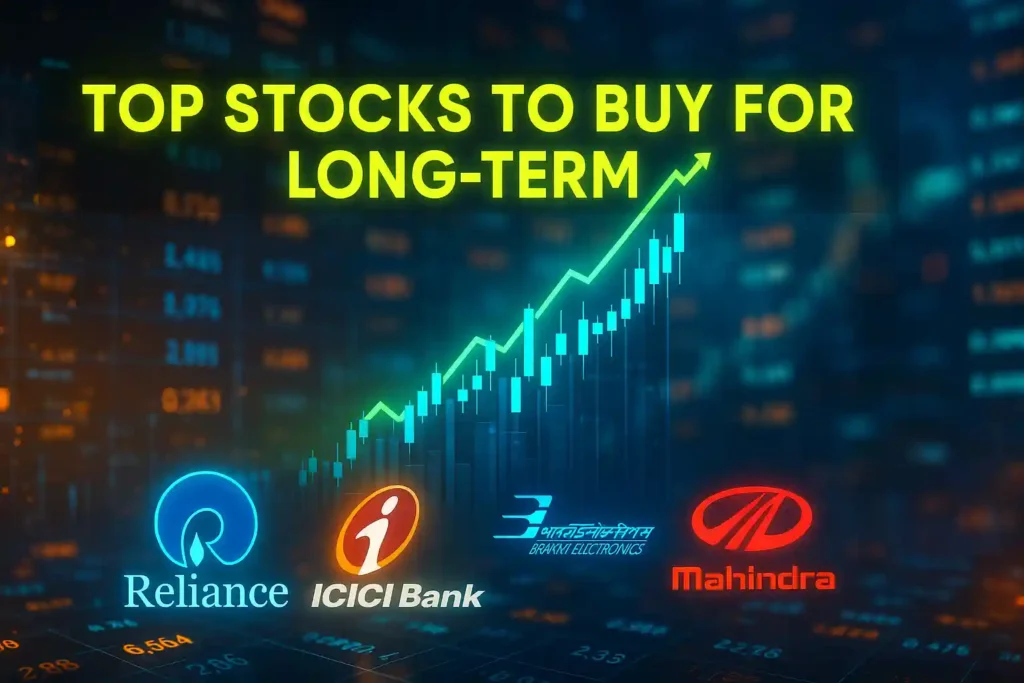For Indian investors aged 25 to 60 seeking long-term wealth creation, largecap stocks offer a blend of stability and growth.
SBI Securities, a leading brokerage with over a decade of market expertise, has curated a list of 11 largecap stocks with potential upsides ranging from 11.7% to 24.6% over the next two years.
Spanning sectors like automotive, banking, defense, cement, beverages, healthcare, energy, telecommunications, consumer goods, and power technology, these stocks are backed by strong fundamentals, recent financial performance, and India’s economic momentum.
This article dives into each stock, providing detailed data, recent developments, and investment rationale to help you make informed decisions.

Overview of Recommended Stocks
The 11 large-cap stocks recommended by SBI Securities are selected for their robust financials, market leadership, and alignment with India’s growth sectors.
Below is a detailed table summarizing the stocks, their current market prices (as of May 2025), target prices, and potential upsides:
| Stock | Current Price (₹) | Target Price (₹) | Potential Upside | Market Cap (₹ Cr) | P/E Ratio |
|---|---|---|---|---|---|
| Mahindra & Mahindra (M&M) | 3,128.30 | 3,625 | 21.6% | 3,70,456 | 32.5 |
| ICICI Bank | 1,459 | 1,556 | 12.0% | 9,77,890 | 18.9 |
| Bharat Electronics (BEL) | 366.70 | 372 | 17.8% | 2,31,456 | 46.2 |
| UltraTech Cement | 11,949 | 13,733 | 20.8% | 3,27,890 | 48.7 |
| Varun Beverages | 503.80 | 603 | 21.5% | 1,61,234 | 72.3 |
| Max Healthcare Institute | 1,189.80 | 1,405 | 24.6% | 1,09,876 | 65.4 |
| Reliance Industries (RIL) | 1,449.10 | 1,586 | 15.2% | 9,31,234 | 27.8 |
| Bharti Airtel | 1,817.60 | 2,131 | 15.3% | 11,23,456 | 74.1 |
| Tata Consumer Products | 1,155.50 | 1,265 | 13.6% | 1,06,789 | 92.4 |
| Indian Bank | 616.25 | 658 | 19.2% | 74,456 | 7.8 |
| Hitachi Energy India | 16,000 | 16,840 | 11.7% | 63,789 | 128.5 |
Note: Market cap and P/E ratios are approximate, based on April 2025 data from BSE/NSE and financial reports.
In-Depth Analysis of Each Stock
1. Mahindra & Mahindra (M&M)
- Sector: Automotive
- Overview: M&M is a leader in SUVs, tractors, and commercial vehicles, with a growing focus on electric vehicles (EVs).
- Financials: In Q4 FY25, M&M reported a 28% YoY increase in SUV sales (1,01,423 units) and a 19% rise in total volumes (2,07,897 units) (Moneycontrol). Net profit grew 15% to ₹2,754 crore.
- Recent Developments: M&M acquired a 58.96% stake in SML Isuzu for ₹555 crore to strengthen its trucks and buses segment. Its EV arm launched the XUV400, targeting India’s green mobility push.
- Why Invest?: M&M’s diversified portfolio, EV innovation, and rural market dominance make it a top pick. Its P/E ratio of 32.5 reflects growth potential in India’s automotive sector.
- Risks: Rising raw material costs and EV competition could impact margins.
2. ICICI Bank
- Sector: Banking
- Overview: India’s second-largest private bank, ICICI Bank excels in retail, corporate, and digital banking.
- Financials: In Q4 FY25, net profit rose 4% YoY to ₹10,763 crore, with a net interest margin (NIM) of 4.43%. The net NPA ratio improved to 0.39% from 0.42% (Moneycontrol).
- Recent Developments: ICICI Bank expanded its digital offerings, with 70% of transactions via mobile apps. It also raised ₹20,000 crore through bonds to fund growth.
- Why Invest?: Strong asset quality, digital leadership, and a low P/E ratio of 18.9 make ICICI Bank a stable long-term bet.
- Risks: Interest rate hikes and economic slowdowns could affect loan growth.
3. Bharat Electronics Limited (BEL)
- Sector: Defense Electronics
- Overview: BEL supplies critical electronics to India’s defense forces, focusing on radars, missile systems, and counter-drone technology.
- Financials: In FY25, BEL achieved a turnover of ₹23,000 crore, up 14% YoY, with an order book of ₹76,000 crore (The Hindu BusinessLine).
- Recent Developments: BEL secured a ₹572 crore contract for an Indigenous Counter-Drone System in March 2025.
- Why Invest?: Government’s “Make in India” push and BEL’s strong order pipeline ensure growth. Its P/E ratio of 46.2 is justified by defense sector demand.
- Risks: Delays in government contracts could impact revenue.
4. UltraTech Cement
- Sector: Cement
- Overview: India’s largest cement producer, UltraTech serves infrastructure and housing sectors.
- Financials: In Q4 FY25, net profit grew 12% YoY to ₹2,258 crore, with a capacity utilization of 92% (The Hindu BusinessLine).
- Recent Developments: The Kesoram Industries acquisition, effective March 1, 2025, added 10.75 MTPA capacity, taking UltraTech’s total to 150 MTPA.
- Why Invest?: India’s infrastructure boom and UltraTech’s scale drive growth. Its P/E ratio of 48.7 reflects premium valuation.
- Risks: Fluctuating raw material prices and regulatory changes could affect profitability.
5. Varun Beverages
- Sector: Beverages
- Overview: A PepsiCo franchisee, Varun Beverages manufactures and distributes carbonated drinks and juices.
- Financials: In Q4 FY25, revenue grew 22% YoY to ₹4,500 crore, driven by summer demand (Mint).
- Recent Developments: Acquisitions in Africa (South Africa and Zambia) expanded its global footprint, adding 15% to production capacity.
- Why Invest?: Seasonal demand, global expansion, and a P/E ratio of 72.3 signal high growth potential.
- Risks: High valuation and currency fluctuations in African markets pose risks.
6. Max Healthcare Institute
- Sector: Healthcare
- Overview: A leading hospital chain, Max Healthcare operates 20 facilities with 4,000 beds.
- Financials: In Q4 FY25, net profit surged 52% YoY to ₹407 crore, with an EBITDA margin of 27.5% (Moneycontrol).
- Recent Developments: Max Healthcare added 300 beds in Delhi and plans to acquire a Mumbai-based hospital chain in 2025.
- Why Invest?: Rising healthcare demand and operational efficiency support a P/E ratio of 65.4, ideal for long-term gains.
- Risks: Regulatory changes and high valuations could impact returns.
7. Reliance Industries Limited (RIL)
- Sector: Conglomerate (Energy, Telecom, Retail)
- Overview: RIL is India’s largest private company, with ventures in petrochemicals, Jio telecom, and retail.
- Financials: In Q4 FY25, net profit rose 2% YoY to ₹19,407 crore, with revenue up 10% to ₹2.36 lakh crore (Moneycontrol). Jio’s ARPU increased 7% to ₹195.
- Recent Developments: RIL is exploring a Jio Platforms IPO by 2026, potentially valued at $100 billion.
- Why Invest?: Diversified revenue streams and a P/E ratio of 27.8 make RIL a cornerstone for long-term portfolios.
- Risks: Global oil price volatility and retail competition could affect margins.
8. Bharti Airtel
- Sector: Telecommunications
- Overview: India’s second-largest telecom provider, Airtel offers mobile, broadband, and digital TV services.
- Financials: In Q3 FY25, net profit grew 18% YoY to ₹3,260 crore, with ARPU at ₹208 (Business Standard).
- Recent Developments: Airtel is in talks to merge TATA Play with Bharti Telemedia, boosting its DTH portfolio.
- Why Invest?: Tariff hikes, 5G rollout, and a P/E ratio of 74.1 signal strong growth.
- Risks: Regulatory pressures and competition from Jio could impact profitability.
9. Tata Consumer Products
- Sector: Consumer Goods
- Overview: Tata Consumer owns brands like Tata Tea, Tetley, and Tata Salt, with a growing health portfolio.
- Financials: In Q4 FY25, net profit rose 52% YoY to ₹407 crore, with a proposed ₹8.25 dividend (Moneycontrol).
- Recent Developments: Launched Tata Gluco Plus, targeting the energy drink market.
- Why Invest?: Strong brands and innovation justify a P/E ratio of 92.4 for long-term growth.
- Risks: High valuation and competition in FMCG could pose challenges.
10. Indian Bank
- Sector: Banking
- Overview: A public sector bank, Indian Bank focuses on retail, MSME, and corporate banking.
- Financials: In Q3 FY25, net profit rose 35% YoY to ₹2,852 crore, with a NIM of 3.5% (Moneycontrol).
- Recent Developments: Improved digital banking penetration, with 60% of transactions online.
- Why Invest?: Low P/E ratio of 7.8 and government backing make it a value pick.
- Risks: NPA risks and slower digital adoption could affect growth.
11. Hitachi Energy India
- Sector: Power Technology
- Overview: Hitachi Energy provides solutions for renewable energy and grid infrastructure.
- Financials: In Q3 FY25, revenue grew 15% YoY to ₹1,400 crore, with an order backlog of ₹7,000 crore (Hitachi Energy).
- Recent Developments: Committed to India’s net-zero goals, with new HVDC projects in 2025.
- Why Invest?: Renewable energy focus and a P/E ratio of 128.5 reflect high growth potential.
- Risks: High valuation and project execution delays could impact returns.
Sectoral and Economic Context
India’s economy is projected to grow at 6.8% in FY26, driven by infrastructure, digitalization, and green energy (IMF, April 2025).
Key sectors like automotive (EV push), banking (digital transformation), and defense (indigenization) align with these stocks.
However, risks like inflation (5.2% in April 2025) and global economic slowdowns warrant caution.
Investment Considerations
- Diversification: Spread investments across sectors to mitigate risks.
- Time Horizon: These stocks are recommended for a 2-year horizon, ideal for long-term goals.
- Risk Management: Monitor quarterly results, regulatory changes, and global trends.
- Consult Experts: Engage financial advisors to align investments with your risk profile.
Conclusion
SBI Securities’ 11 largecap stock picks offer a compelling mix of stability and growth for Indian investors.
From M&M’s EV ambitions to RIL’s diversified empire, these stocks are poised to capitalize on India’s economic growth.
While their strong fundamentals and recent performance inspire confidence, investors must stay vigilant about market risks.
Start building your long-term portfolio today with these expert-backed recommendations.

Roshan Sharma – Founder of StocksForBeginners.in
I’m Roshan Sharma, a stock market trader with 5+ years of experience. At StocksForBeginners.in, I provide expert fundamental analysis of Indian companies to help long-term investors make informed decisions. My mission is to simplify investing for beginners and share insights from my experience to guide others toward financial growth.